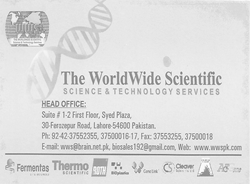Full Length Research Article
RETRACTED ARTICLE: Investigations on molecular determinants of durable molecular response in chronic myeloid leukemia patients
Zafar Iqbal
Adv. life sci., vol. 9, no. 1, pp. 67-74, May 2022
*- Corresponding Author: Zafar Iqbal (Email: drzafar.medgen@yahoo.com)
Authors' Affiliations
Editorial Expression of Concern
20 June 2025: Following publication of this paper, the internal audit (consequent to concerns on quality raised by Web of Science) notified Advancements in Life Sciences about suspected plagiarism. By this Editorial Expression of Concern, we alert the scientific community of the errors as we reconcile the records.
Editorial Note
25 June 2025: While rerunning the Turnitin originality analysis, a similarity index of 47% was found for this article (10% from a single source). Editorial board of Advancements in Life Sciences has started the process of retracting this article due to the above post-publication findings. The process shall be concluded after registering responses from the authors. Meanwhile, full text of the article shall remain unavailable for citations (this notice has been updated following insights derived from relevant COPE cases and the industry standards). Show of cause notice has also been issued to the concerned editorial team member.
Retraction Note
23 July 2025: The Editor-in-Chief, upon the recommendation of the Inquiry Team, has retracted this article due to plagiarism. An internal audit revealed that several articles, including this one, exhibited a high similarity index without proper disclosure or attribution by the authors. This constitutes a breach of the journal’s editorial policy, and the article is therefore being retracted.
Abstract![]()
Introduction
Methods
Results
Discussion
References
Abstract
Background: Chronic myeloid leukemia (CML), a blood cancer, is caused by translocation between chromosomes 22 and 9 that gives rises to fusion oncogene BCR-ABL. In 20th century, CML was a deadly disease, but tyrosine kinase inhibitors (TKI) led to complete remission in over 80% CML patients. Nevertheless, TKIs are expensive, and discontinuation of treatment is required in patients with very stable treatment response. As no molecular markers of durable TKI response exist, this study was conducted to find out molecular determinants of durable response in CML patients treated with TKIs.
Methods: Peripheral blood and clinical data were collected from CML patients with durable treatment response, along with appropriate controls. DNA was extracted and whole exome sequencing (WES) carried out to screen novel genes mutated only in experimental groups and absent in control groups. Mutations were confirmed using Sanger sequencing. Data was analyzed using SPSS version 23.
Results: Although WES detected 10 genes mutated exclusively in CML patients with durable treatment response, Sanger sequencing could confirm mutations only in RAI1 gene (GC deletion at nucleotides 837-838, a frameshift mutation).
Conclusions: Our study shows that mutations in a novel gene (RAI1) are associated with durable response in CML patients. RAI1 gene is active throughout the body and controls functions of many genes involved in daily rhythms. Our studies provide first important insights into molecular factors associated with long-term treatment response in CML that can serve as novel biomarker to identify patients eligible for TKI cessation in many ongoing CML STOP-TKI trials.
Keywords: CML; TKI therapy; Durable response; Molecular biomarkers; STOP-TKI



